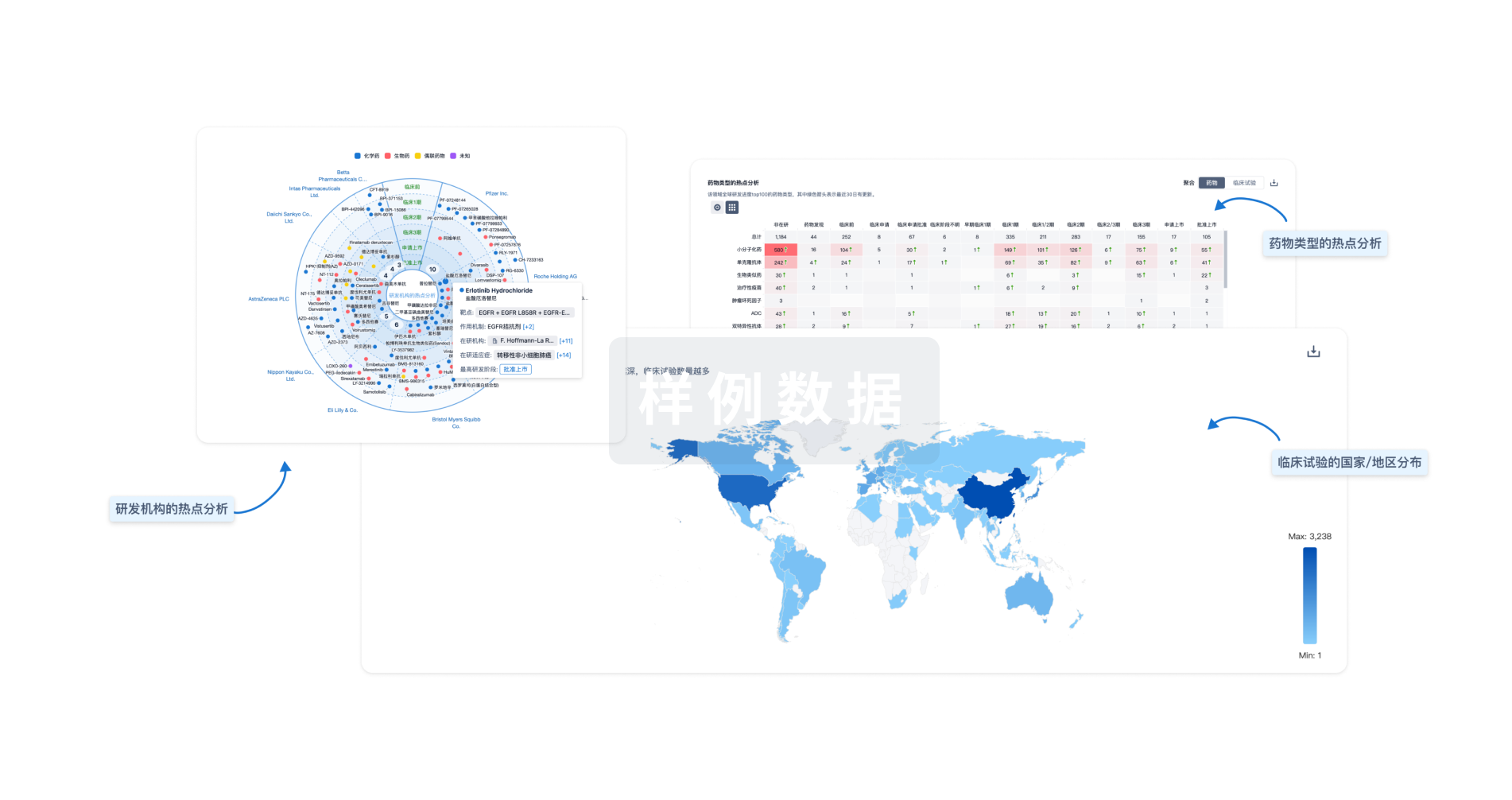预约演示
更新于:2025-05-07
influenza A subtype H3N2 infection
H3N2流感
更新于:2025-05-07
基本信息
别名 Influenza A (H3N2)、influenza A H3N2、influenza A subtype H3N2 infection + [2] |
简介- |
关联
4
项与 H3N2流感 相关的药物靶点- |
作用机制 免疫刺激剂 |
在研机构 |
原研机构 |
在研适应症 |
非在研适应症 |
最高研发阶段批准上市 |
首次获批国家/地区 中国 |
首次获批日期2021-03-02 |
靶点- |
作用机制 免疫刺激剂 |
在研机构 |
非在研适应症- |
最高研发阶段批准上市 |
首次获批国家/地区 俄罗斯 |
首次获批日期1993-12-21 |
靶点- |
作用机制 免疫刺激剂 |
在研机构 |
原研机构 |
在研适应症 |
非在研适应症- |
最高研发阶段申请上市 |
首次获批国家/地区- |
首次获批日期1800-01-20 |
5
项与 H3N2流感 相关的临床试验CTR20223413
随机、双盲、阳性对照评价四价流感病毒裂解疫苗在3岁及以上人群中接种的免疫原性和安全性的Ⅲ期临床试验
评价四价流感病毒裂解疫苗在3岁及以上健康人群中接种的免疫原性和安全性。
开始日期2023-03-03 |
申办/合作机构 |
CTR20220581
多中心、随机、双盲、阳性对照和安慰剂对照的三臂设计,评价鼻喷流感减毒活疫苗在3~59周岁健康人群中的免疫原性和安全性的Ⅱ期临床试验
主要目的:评价鼻喷流感减毒活疫苗在3~59周岁健康人群中接种的免疫原性;
次要目的:评价鼻喷流感减毒活疫苗在3~59周岁健康人群中接种的安全性。
开始日期2022-03-18 |
申办/合作机构 |
CTR20212179
单中心、随机、双盲、安慰剂对照评价鼻喷流感减毒活疫苗在3~59周岁健康人群中的安全性和免疫原性的Ⅰ期临床试验
主要目的:评价鼻喷流感减毒活疫苗在3~59周岁健康受试者中接种的安全性。
次要目的:观察鼻喷流感减毒活疫苗在3~59周岁健康受试者中的免疫原性。
开始日期2021-12-07 |
申办/合作机构 |
100 项与 H3N2流感 相关的临床结果
登录后查看更多信息
100 项与 H3N2流感 相关的转化医学
登录后查看更多信息
0 项与 H3N2流感 相关的专利(医药)
登录后查看更多信息
216
项与 H3N2流感 相关的文献(医药)2025-02-25·Journal of Virology
Modulation of cytokeratin and cytokine/chemokine expression following influenza virus infection of differentiated human tonsillar epithelial cells
Article
作者: Webster, Robert G. ; Abdelsamed, Hossam A. ; Miller, Lance ; Thomas, Paul G. ; Okda, Faten A. ; Vegesana, Kasi ; Langfitt, Deanna M. ; Perry, S. Scott ; Kandeil, Ahmed ; Sakr, Ahmed Atef ; DeBeauchamp, Jennifer ; Webby, Richard J. ; Jones, Jeremy ; Crawford, Jeremy Chase ; Kercher, Lisa ; Ghonim, Mohamed ; Brice, David C.
2024-12-16·The Journal of Infectious Diseases
Humoral Correlates of Protection Against Influenza A/H3N2 Virus Infection
Article
作者: Krammer, Florian ; Yellin, Temima ; López, Roger ; Hoy, Gregory ; Kuan, Guillermina ; Ojeda, Sergio ; Stadlbauer, Daniel ; Gordon, Aubree ; Balmaseda, Angel ; Plazaola, Miguel ; Sánchez, Nery ; Carreno Quiroz, Juan Manuel ; Frutos, Aaron
2024-06-01·International Journal of Infectious Diseases
Association of viral loads of influenza A (H3N2) with age and care setting on presentation—a prospective study during the 2022-2023 influenza season in Spain
Article
作者: Domínguez-Gil, Marta ; Hernández, Marta ; Arroyo-Hernantes, Irene ; Rodríguez-Crespo, Carla ; Eiros, José M ; Sánchez-Martínez, Javier ; Rojo-Rello, Silvia ; Sanz-Muñoz, Iván
46
项与 H3N2流感 相关的新闻(医药)2025-04-15
·药融圈
注:本文不构成任何投资意见和建议,以官方/公司公告为准;本文仅作医疗健康相关药物介绍,非治疗方案推荐(若涉及),不代表平台立场。任何文章转载需得到授权。mRNA 疫苗作为疫苗领域的新兴力量,凭借独特的作用机制和诸多优势,自问世以来便备受瞩目。从新冠疫情期间大放异彩,到如今在多种疾病预防与治疗领域不断探索,其研发进展一直是医药界关注焦点。2025 年 1-3 月,mRNA 疫苗领域持续发力,在多个项目上取得关键突破。1、BioNTech 与罗氏合作的 iNeST1 月 6 日,国际顶级医学期刊《Nature Medicine》发布了 BioNTech 与罗氏合作研发的个体 mRNA 新生抗原疫苗 Autogene Cevumeran(iNeST)的 I 期临床研究进展。该疫苗通过激活患者特异性 T 细胞免疫应答,在晚期实体瘤治疗中展现出显著的安全性及初步抗肿瘤活性。晚期实体瘤患者预后较差,传统治疗手段效果有限,这款疫苗的进展为肿瘤免疫治疗开辟新思路,后续研究将聚焦于扩大样本量、优化联合治疗方案等,进一步验证其临床价值 。2、阿法纳生物 VZV mRNA 疫苗1 月 24 日,阿法纳生物研发的带状疱疹病毒(VZV)mRNA 疫苗(AFN1204 注射液)IND 申请获得 CDE 受理,拟适用于预防水痘 - 带状疱疹病毒(VZV)感染导致的带状疱疹疾病。带状疱疹是由潜伏在体内的 VZV 再激活所致,以沿单侧周围神经分布的簇集性小水疱为特征,常伴有显著神经痛,严重影响患者生活质量。阿法纳生物的这款 mRNA 疫苗有望通过诱导机体产生针对 VZV 的特异性免疫应答,预防疾病发生,若研发成功,将为带状疱疹预防提供新的有力手段 。3、百克生物 II 型单纯疱疹病毒 mRNA 疫苗同样在 1 月 24 日,百克生物在互动平台表示其 II 型单纯疱疹病毒 mRNA 疫苗临床试验申请获得批准。II 型单纯疱疹病毒主要引起生殖器疱疹,是一种常见的性传播疾病,复发率高,目前缺乏彻底治愈方法。百克生物布局该领域,借助 mRNA 疫苗技术,期望开发出能有效预防病毒感染、降低复发风险的疫苗产品,其获批临床试验,标志着国内在该类疫苗研发上迈出重要一步 。4、立康肿瘤新生抗原mRNA疫苗2月初,立康生命科技团队自主研发的肿瘤新生抗原mRNA疫苗产品——LK101注射液成功获得美国食品药品监督管理局(FDA)的IND(临床试验申请)批准。成为中国首个出海 mRNA 肿瘤疫苗,其基于 AI 算法预测肿瘤新生抗原,48 小时内完成靶点筛选,Ⅰ 期试验显示抗肿瘤活性显著。5、石药集团带状疱疹 mRNA 疫苗2 月 6 日,石药集团巨石生物申报的 “SYS6017(带状疱疹 mRNA 疫苗)” 获 CDE 批准开展临床试验,为国内获批临床试验的第 4 款预防带状疱疹 mRNA 相关药物。石药集团凭借自身研发实力,加入带状疱疹 mRNA 疫苗研发赛道,此前其在新冠 mRNA 疫苗研发等方面积累了经验,此次针对带状疱疹的 mRNA 疫苗研发,有望为患者带来更多选择,进一步丰富国内 mRNA 疫苗产品管线 。6、中国首款 mRNA 流感疫苗2 月 21 日,中国首款 mRNA 流感疫苗正式获得国家药监局批准进入 I 期临床试验,成为一大亮点。该疫苗针对 H3N2 毒株,生产周期仅需 2 个月,大大缩短了传统流感疫苗的制备时间,在应对流感病毒快速变异方面具有明显优势。临床前试验显示,其对 H3N2 流感病毒的免疫反应率达到 85%,首批 300 名志愿者已完成接种。若后续临床试验顺利,将为流感防控注入新活力,提供更高效的预防方案 。7、云顶新耀mRNA肿瘤疫苗 EVM163 月 6 日,云顶新耀宣布其自主研发的首款新型 mRNA 个性化肿瘤治疗性疫苗 EVM16 已在北京大学肿瘤医院顺利完成首例患者给药。EVM16 是 AI 算法驱动识别肿瘤新抗原的疫苗,临床试验项目 EVM16CX01 旨在评估其单药及联合 PD - 1 抗体治疗在晚期或复发实体瘤受试者的安全性、耐受性、免疫原性和初步疗效。肿瘤治疗一直是医学难题,个性化肿瘤疫苗是前沿探索方向,云顶新耀此举有望借助 mRNA 技术和 AI 精准识别,为晚期肿瘤患者带来新希望 。8、Moderna 有望推出首款 mRNA 肿瘤疫苗3 月 5 日,美国 Moderna 疫苗公司在投资者大会上透露,其有望于 2027 年推出全球首款 mRNA 肿瘤疫苗。该疫苗与免疫检查点抑制剂联合使用,在针对黑色素瘤的 II 期临床试验中,与 Keytruda 联用使得患者的复发或死亡风险降低了 44%。目前该疫苗正同步开展三项 III 期临床试验,涵盖黑色素瘤、非小细胞肺癌、鳞癌。Moderna 在 mRNA 技术领域底蕴深厚,新冠 mRNA 疫苗的成功让其在研发上更具优势,若这款肿瘤疫苗获批上市,将彻底改变肿瘤治疗格局 。9、中国首个新型结核病 mRNA 疫苗3 月 24 日,中国首个自主研发的新型结核病 mRNA 疫苗启动临床试验,在北京胸科医院临床试验病房为首个受试者接种疫苗,这是 mRNA 疫苗在传染病预防领域的新突破。动物免疫原性试验和攻毒实验显示,该新型 mRNA 疫苗的保护效力相较于传统卡介苗疫苗和国外著名的亚单位疫苗 M72 提高了 20 倍以上,展现出巨大潜力。2025 年 1-3 月的 mRNA 疫苗进展,无论是在传染病预防如流感、带状疱疹,还是在肿瘤治疗领域,都展现出蓬勃发展态势。参考资料:公开资料版权声明:本文转自细胞基因治疗前沿,如不希望被转载的媒体或个人可与我们联系,我们将立即删除会议推荐 | 点击查看详情植根上海、辐射全球,药融圈作为生物医药产业级战略平台,以"让智慧与人脉无界流动"为使命,构建覆盖药物研发、生产、流通、商业化的全产业链赋能体系。通过智能化云服务、精准资源链接、产业智库与生态社群四大核心引擎,打造中国医药价值流动的基础设施。在全球化与数字化双重浪潮下,药融圈正重新定义医药资源的流通范式--这里不仅是信息与人脉的枢纽站,更是催生产业变革的化学反应器。我们以中国为原点,编织全球医药智慧网络,让每一次精准链接都成为企业跨越式增长的催化剂。点点赞点分享点推荐
临床1期信使RNA临床申请疫苗免疫疗法
2025-03-31
·梅斯医学
2025年3月27日,国家药品监督管理局(NMPA)正式批准青峰医药集团下属子公司科睿药业有限公司自主研发的新一代抗流感药物玛舒拉沙韦片(商品名:伊速达®)上市,获批适应症为既往健康的12岁及以上青少年和成人单纯性甲型和乙型流感患者的治疗,为应对流感提供了新的用药选择。 根据中国疾病预防控制中心(CDC)的数据显示,2024年冬季全国门急诊流感样病例占比(ILI%)在12月接近近十年来的最高水平1,流感高发趋势明显,医疗系统承压严重。而现有抗流感药物由于长期使用,耐药突变率逐年上升,临床治疗效果受限,亟需一种疗效更佳、耐药风险更低的新型抗病毒药物。玛舒拉沙韦片作为中国首个自主研发的PA抑制剂,由青峰医药历时十余年研发,作为新一代PA抑制剂,通过结构优化与靶点创新,展现出更佳疗效和更低耐药风险,将有效解决当前抗流感治疗的临床困境。与传统抗流感药物不同,玛舒拉沙韦片通过抑制流感病毒RNA聚合酶酸性蛋白(PA)亚基,快速阻断病毒mRNA的合成,从而迅速抑制病毒复制。基于这一创新的作用机制,玛舒拉沙韦实现了“全疗程一次用药”的治疗效果,患者仅需单次口服即可在22小时内迅速清除病毒2。此次获批是基于中日友好医院曹彬教授团队牵头开展的III期临床研究成果,文章发表于《Nature Medicine》(IF=58.7),所有临床数据100%来自中国人群。图:《Nature Medicine》该研究采用严格的多中心、随机、双盲、安慰剂对照设计,纳入588例患者。研究结果表明,玛舒拉沙韦片可显著缩短整体流感症状的缓解时间,中位为42.0小时,较安慰剂组(63.0小时)缩短21小时;同时显著加快退热速度,中位退热时间为19.7小时。此外,不良事件发生率与安慰剂类似,未发现需特殊关注的安全性不良事件,安全性良好。图:玛舒拉沙韦组和安慰剂组的流感症状缓解时间曲线玛舒拉沙韦片的Ⅱ期临床研究针对乙流同样取得了显著成果。研究数据显示,治疗乙型流感的症状缓解时间较安慰剂组缩短32.3小时3,为乙型流感的临床治疗提供了有力的循证支持。值得关注的是,针对现有抗流感病毒药物存在的耐药问题,玛舒拉沙韦片的耐药优势明显。临床研究中,其在甲型流感H1N1和H3N2亚型病毒的耐药突变率仅为0.7%和0.9%2,治疗甲流突变位点仅1个,且突变率<1%。乙型流感患者未检测到耐药突变,体现了较低的耐药风险,适于广泛长期的临床使用。青峰医药表示,将持续推进玛舒拉沙韦片在儿童、流感预防及高风险人群中的临床研究,并优化药物剂型,精准满足不同患者需求。作为中国医药工业百强企业,青峰医药具备完整的研发、生产与商业化能力,年产片剂超45亿片,将有效缓解国内抗流感药物供应压力。 玛舒拉沙韦片的成功上市,不仅为临床医生提供了安全、高效且耐药风险较低的新型治疗选择,更是我国抗流感药物领域的重要里程碑,必将惠及更多流感患者,助力公共卫生防控水平的提升。参考链接:1.https://www.chinacdc.cn/jksj/jksj04_14249/202503/P020250313740556275395.pdf2.Wang, Y., et al. Nat Med 31, 639–646 (2025).3.Wang Y, Wang H, Liu D, et al.Clin Microbiol Infect. 2025 Jan 25. doi:10.1016/j.cmi.2025.01.025.免责声明:本文仅作最新前沿信息交流之目的,文中所有观点不代表梅斯医学立场,亦不代表梅斯医学支持或反对文中观点。如需获得治疗方案指导,请前往正规医院就诊!
上市批准临床2期临床结果信使RNA临床3期
2025-03-31
·医脉通
前言流感是世界级的公共卫生问题,当前已出现的耐药突变,给现有抗流感病毒药物的有效性带来巨大挑战,临床治疗面临困境1。在此背景下,玛舒拉沙韦片获批上市,为流感治疗领域注入了新活力。玛舒拉沙韦片获批——中国智造“全程一次用药”“广谱”抗流感新“武器”2025年3月27日,国家药品监督管理局官网发布公告,批准青峰医药集团下属子公司科睿药业有限公司申报的1类创新药伊速达玛舒拉沙韦片上市,用于既往健康的12岁及以上青少年和成人单纯性甲型和乙型流感患者的治疗2。据悉,该药物是我国自主研发的首个靶向聚合酶酸性蛋白(polymerase acid protein,PA)流感抗病毒药物,是我国抗流感病毒药物领域的一大突破。从作用机制来看,玛舒拉沙韦片是一种前药,通过水解转化为活性代谢产物舒拉沙韦,发挥抗流感病毒活性;舒拉沙韦可抑制PA(病毒基因转录所需RNA聚合酶复合物中的一种流感病毒特异性酶)的核酸内切酶活性,从而抑制流感病毒复制3。舒拉沙韦对多种实验室流感病毒株,包括甲型(H1N1、H3N2)、乙型流感(B/Lee/40)、禽流感病毒(H5N1、H5N6、H6N1、H7N4、H7N9、H9N2、H10N8)具有抗病毒活性,EC50为0.22~16.82nM3。在玛舒拉沙韦片的用法用量方面,在症状出现后48小时内单次口服40mg,可与或不与食物同服;体重≥20kg,一次40mg,一日1次;体重<20kg ,推荐给药2mg/kg,一日1次3。这种全程一次用药的方式,可很大程度地提高患者的用药依从性。疾病负担与耐药现状——流感阴影下的全球困境据世界卫生组织估计,流感在全球每年导致29万~65万例呼吸道疾病相关死亡4。我国流行病学数据表明,在2010-2011至2014-2015年流感季,中国平均每年有8.8万例流感相关超额死亡(excess deaths)5。在甲型流感病毒中,H1N1和H3N2亚型可引起季节性和大流行性感染6。根据我国《流行性感冒诊疗方案(2025年版)》,流感流行季,有流感重型/危重型高危因素的流感样病例,应尽早进行抗病毒治疗,发病48小时内进行抗病毒治疗获益最大6。因此,抗流感病毒的药物治疗仍是流感治疗的重要策略1。迄今为止,已有多种小分子抗流感病毒药物陆续投入临床,为人类对抗流感病毒引起的急性呼吸道感染提供了有力的“武器”1。然而,流感病毒快速突变的特点使其逐渐对传统的抗病毒药物耐药,使得现有抗流感病毒药物的有效性存在降低趋势1。Q面对流感病毒耐药致使药物有效性降低的棘手现状,如何破局?玛舒拉沙韦片的及时获批,恰逢其时,为解决这一治疗难题带来了新的希望。其II、III期研究结果成绩斐然,为临床应用注入强大信心。Ⅲ/Ⅱ期研究——临床实力的强势见证①Ⅲ期研究荣登Nature,中国数据获国际认可,耐药风险低,更具临床优势玛舒拉沙韦片注册临床数据全部来源于中国患者,拥有充分的中国人群循证证据。曹彬教授团队主导的玛舒拉沙韦片的III期临床(NCT05474755)数据发表于国际期刊《Nature Medicine》(IF=58.7)8。这是一项多中心、分层随机、双盲、安慰剂平行对照III期临床研究,旨在验证玛舒拉沙韦片在改善流感症状和清除病毒的有效性和安全性,以及耐药事件发生率8。研究显示:玛舒拉沙韦片——中位流感症状缓解时间缩短21小时,发热缓解时间缩短8.6小时玛舒拉沙韦片组的流感症状缓解时间中位数显著短于安慰剂组(42.0h vs. 63.0h;HR=1.85,95%CI=1.33-2.57)。在敏感性分析中主要终点结果保持稳定,并在亚组分析中观察到了玛舒拉沙韦片的类似结果。此外,与服用安慰剂的患者相比,服用玛舒拉沙韦片组的患者退热的中位时间显著缩短(19.7h vs. 28.3h)8。图1:玛舒拉沙韦片组 vs. 安慰剂组,流感症状缓解时间曲线8玛舒拉沙韦片——中位病毒清除时间为22小时,较安慰剂组缩短24.9小时玛舒拉沙韦片中位病毒清除时间为22小时,较安慰剂组缩短24.9小时(P<0.001)。与安慰剂组相比,玛舒拉沙韦片组在用药后第1天的病毒载量从基线下降的速度更快,玛舒拉沙韦片组病毒载量的平均变化为-2.2±1.3 log10 copies/ml,安慰剂组为-1.3±1.7 log10 copies/ml8。图2:不同访视点,玛舒拉沙韦片组 vs. 安慰剂组,病毒载量变化情况8玛舒拉沙韦片——安全性良好玛舒拉沙韦片组和安慰剂组的不良事件的发生率以及药物相关的不良事件的发生率类似,大多数不良事件为轻度至中度,无需对症治疗即可缓解,且未发生导致死亡的严重不良事件8。玛舒拉沙韦片——耐药风险低玛舒拉沙韦片组仅有3名参与者在用药第5天时出现耐药相关的I38T氨基酸替换,H1N1pdm和H3N2亚型的发生率分别为0.7%和0.9%,乙型流感组和安慰剂组未发生突变;耐药表型结果与测序结果一致8。②Ⅱ期研究瞄准乙流,直击临床治疗困境玛舒拉沙韦片的Ⅱ期临床研究针对乙流同样取得了显著成果。研究在18个中国研究中心进行了一项多中心随机、双盲、安慰剂对照的2期临床试验,旨在评价舒拉沙韦对成人无并发症流感患者的治疗效果9。研究中,99.5%为乙流患者,结果显示,玛舒拉沙韦片组流感症状缓解的中位时间较安慰剂组更短(40 mg组:50.0 [44.1 - 71.9] h;20 mg组:46.1 [39.6 - 58.2] h;安慰剂组:82.3 [67.9 - 87.3] h)9。各组不良事件的发生率相似9。在耐药性方面,191 名患者中的365份乙型流感样本中,符合条件的样本中未发现 I38T突变;从365个样本中随机抽取30个样本进行病毒空泡还原试验耐药性检测,药物敏感性未见降低9。破冰之作!中国首个自主研发靶向PA流感药,玛舒拉沙韦片开启抗病毒治疗新时代玛舒拉沙韦片精准作用于流感病毒复制的关键环节,靶向阻断病毒的复制进程3。全病程中,患者仅需服药1次3。临床数据有力证实了玛舒拉沙韦片的显著疗效。其流感症状中位缓解时间较安慰剂组缩短21小时,发热缓解时间缩短8.6小时;病毒清除中位时间为22小时,较安慰剂组缩短24.9小时;用药第1天病毒载量下降更快8。流感病毒易快速突变,逐渐对传统抗病毒药物产生耐药性1。玛舒拉沙韦片在应对耐药难题方面表现突出。其III期研究中仅极少数参与者出现耐药性突变,H1N1pdm、H3N2亚型耐药发生率低至0.7%、0.9%,乙流组和安慰剂组未发生突变8。II期研究耐药性检测未发现药物敏感性降低9。玛舒拉沙韦片这一特性为临床解决病毒耐药引发疗效不佳、病情反复等问题提供了有力支持。作为中国自主研发的创新药物,玛舒拉沙韦片精准发力,为甲型和乙型流感患者开拓了全新的治疗选择;其依托全部源自中国患者的注册临床数据,厚植本土研发实力,开启了抗病毒治疗的崭新时代。参考文献:1.宋融融,等. 流感抗病毒药物治疗进展[J]. 中华医学杂志,2023,103(04):293-299.2.https://www.nmpa.gov.cn/zhuanti/cxylqx/cxypxx/20250327113047141.html3.玛舒拉沙韦片说明书4.Iuliano AD, et al. Lancet, 2018,391(10127): 1285‑1300.5.Li L, et al. Lancet Public Health. 2019,4(9):e473‑e481.6.Park JE, et al. Infect Genet Evol, 2018, 65:288‑292.7.流行性感冒诊疗方案(2025 年版)8.Wang, Y, et al. Nat Med 31, 639–646 (2025).9.Wang Y, et al. Clin Microbiol Infect. Published online January 25, 2025.END医脉通是专业的在线医生平台,“感知世界医学脉搏,助力中国临床决策”是平台的使命。医脉通旗下拥有「临床指南」「用药参考」「医学文献王」「医知源」「e研通」「e脉播」等系列产品,全面满足医学工作者临床决策、获取新知及提升科研效率等方面的需求。
上市批准
分析
对领域进行一次全面的分析。
登录
或

生物医药百科问答
全新生物医药AI Agent 覆盖科研全链路,让突破性发现快人一步
立即开始免费试用!
智慧芽新药情报库是智慧芽专为生命科学人士构建的基于AI的创新药情报平台,助您全方位提升您的研发与决策效率。
立即开始数据试用!
智慧芽新药库数据也通过智慧芽数据服务平台,以API或者数据包形式对外开放,助您更加充分利用智慧芽新药情报信息。
生物序列数据库
生物药研发创新
免费使用
化学结构数据库
小分子化药研发创新
免费使用


